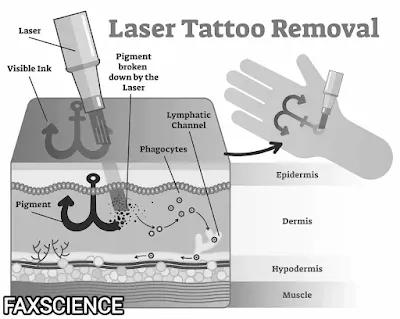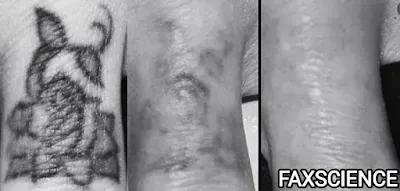In 20th
Century, tattoos have become a necessary art to be a cool teenager. Almost
every teenager has ever had a thought about having a tattoo that will enhance
his/her body features. Thus, tattoos have become an ever-present form of
self-expression in modern society. However, for those seeking to remove an
unwanted tattoo, understanding the science behind the process is very important.
In this blog article, we will dive deep into the science behind tattoo
removal and different types of tattoo removal techniques. Also make sure you
read till the end.
SCIENCE SIMPLIFIED
To understand the science behind tattoo removal, we must first grasp the fundamentals of tattoos themselves. A tattoo is created by injecting ink into the dermis (the second layer of the skin). The ink particles are too large for the body's natural processes to eliminate, resulting in their permanence (they remain unchanged). The immune system recognizes the ink as a foreign substance and encapsulates it within cells, effectively trapping it in place.
Tattoo Removal Techniques
- Laser Tattoo Removal: The most widespread and effective method for tattoo removal is laser treatment. This technique employs high-intensity laser beams that selectively target and break down the tattoo ink. Laser of different wavelengths are utilized to target specific colours within the tattoo. The principle behind this process is known as selective photo thermolysis (it basically means using light to destroy body cells). The laser's energy is absorbed by the tattoo pigment, causing it to shatter into smaller particles that can be gradually eliminated by the body's immune system. Multiple treatment sessions are typically required to achieve complete tattoo removal.
- Intense Pulsed Light (IPL) Therapy: Another approach to tattoo removal is IPL therapy, which employs broad-spectrum light pulses to break down tattoo pigments. While similar to laser treatment, IPL uses a range of wavelengths rather than a single focused beam. This method is most effective for removing lighter colours but may not succeed with darker pigments. Laser removal generally yields better results due to its ability to precisely target specific ink colours.
- Surgical Excision: For small tattoos, surgical excision can be a practical option. This technique involves surgically removing the tattooed skin and then stitching the wound closed. While effective in removing the tattoo entirely, surgical excision may leave a visible scar, and it is typically not recommended for larger tattoos due to its danger for significant scarring.
- Dermabrasion and Chemical Peels: Dermabrasion and chemical peels were once common methods for tattoo removal but have fallen out of favour in recent years. Dermabrasion involves mechanically removing layers of skin containing tattoo ink using a rotating brush or abrasive device. Chemical peels, on the other hand, rely on applying a chemical solution to the skin to shred the outer layers. Both methods can be painful, carry a risk of scarring, and often require multiple sessions for satisfactory results. Laser and IPL treatments have replaced these techniques due to their superior effectiveness and safety profiles.
Factors That Affect Tattoo Removal
There are several factors which may influence
the success and ease of tattoo removal. These include the size of the tattoo,
the colours used, the depth of ink penetration, and its location on the body.
Generally, older tattoos are easier to remove compared to professionally done
or newer ones. Additionally, factors like skin type, immune response, and
overall health can influence the removal process, with variations in results
from person to person.
Risk and Aftercare
Proper aftercare following tattoo removal
procedures is essential to ensure optimal healing and minimize potential risks.
Skin irritation, redness, blistering, scarring, and pigmentation changes are
among most observed side effects. It is important to follow the guidance of a
professional to minimize complications and maximize the chances of a successful
outcome.
Tattoo removal cost in India
Getting rid of a tattoo
in India can cost different amounts. It's like buying different toys where the
price depends on a few things. Let me explain:
- Size and Complexity: If your tattoo is small and not too fancy, it might cost around 1,000 to 2,000 Indian Rupees (INR) for each time you want to remove it. But if it's a big and colourful one, it could cost a lot more.
- Colour of the Tattoo: If your tattoo has lots of colours, like a rainbow, it can be harder to remove. That means it might take more sessions, and each session can cost between 1,000 to 5,000 INR or even more.
- How They Remove It: They usually use special machines called lasers to remove tattoos. Different lasers can cost different amounts. So, the kind of laser they use can affect the price.
- Where You Live: In big cities like Mumbai or Delhi, removing tattoos might be more expensive because everything costs more there. In smaller towns, it might cost less.
- How Many Times: You usually need to go for a few sessions to completely remove a tattoo. So, if you need to go many times, it can add up.
- Starting Checkup: Sometimes, you have to pay a little extra for the first visit to the doctor to check your tattoo and make a plan.
- Taking Care After: After removing the tattoo, you might need some special stuff to help your skin heal. That costs money too.
Conclusion
In conclusion, the science behind tattoo removal
unveils techniques and principles which are very likely to give a successful
outcome. From laser treatments to surgical excision, each method has its own
merits and considerations. By exploring these scientific foundations,
individuals can make informed choices about tattoo removal, embracing the
possibility of a clean slate while appreciating the advancements that science
has brought to this evolving field. Remember, while tattoos can be removed, the
knowledge and insights gained from the experience can leave a permanent mark on
our journey towards understanding the complexities of our own bodies and the
boundless realm of science.
THANK YOU !!! FOR THE READING TILL LAST AND I HOPE YOU ALL LIKED IT & DON'T FORGET TO SHARE THE ARTICLE!!!






